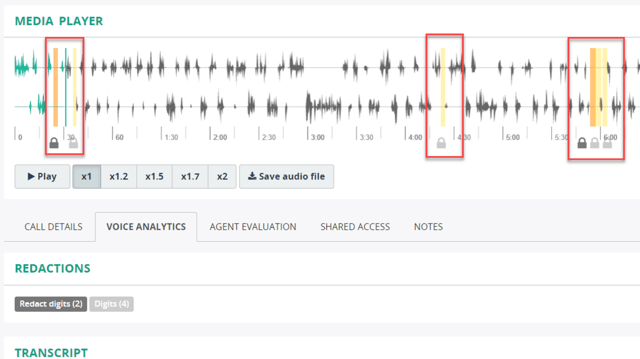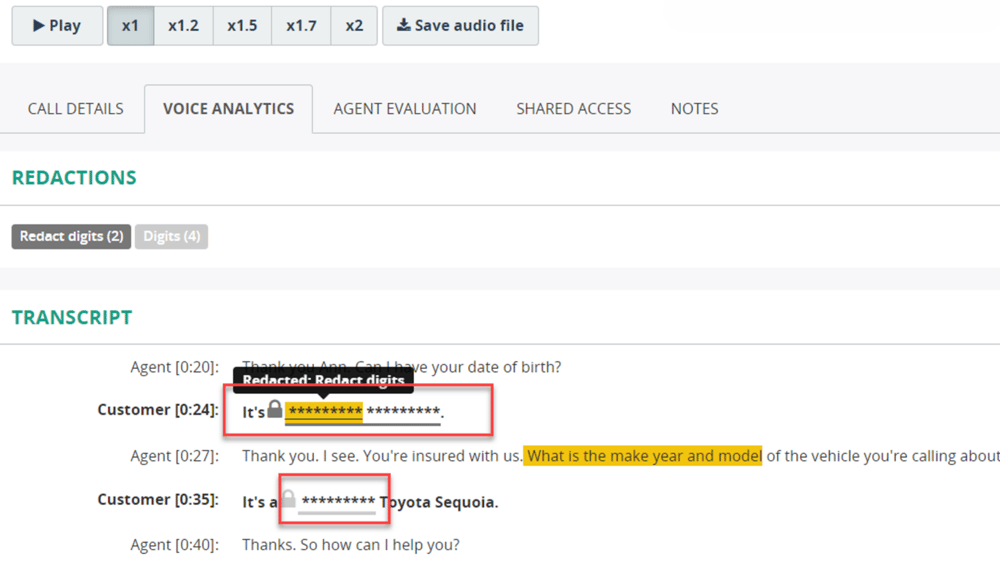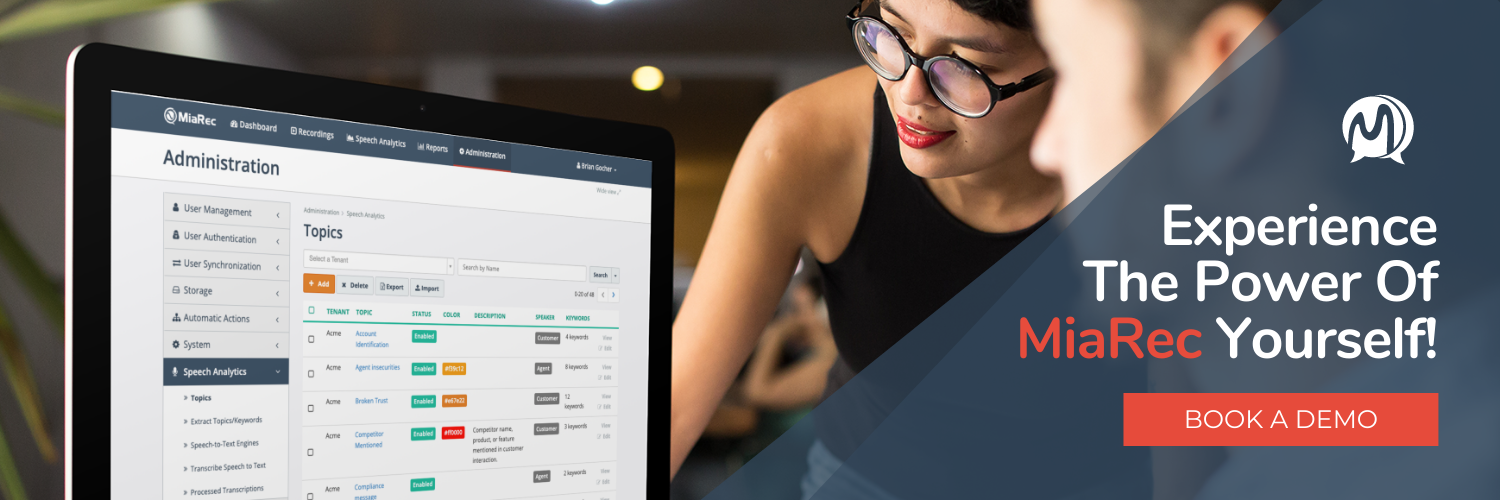MiaRec Now Offers AI-Driven Auto Redaction
In today's digital world, maintaining data privacy and protecting sensitive personal information are more important than ever before. To comply with regulatory compliance, such as GDPR or PCI-DSS, and data security policies, contact centers use redaction to remove sensitive content from the transcripts and audio recordings. This is accomplished by either eliminating or masking personal information such as credit card numbers, social security or account numbers, phone numbers, or dates of birth from call recordings.
Because manual redaction is highly labor-, time-, and resource-intensive, and because relying on your agents to pause and resume the call recording is very unreliable, contact centers require a more scalable, automated solution.
MiaRec Introduces AI-Driven Auto Redaction Feature As Part Of Its Voice Analytics Product
To help organizations protect their customers' data by quickly and easily removing sensitive personal information from transcripts and audio recordings, MiaRec has recently introduced a new AI-driven Auto Redaction feature for its Conversational Analytics Platform. It is specifically designed to identify and remove potentially sensitive data, allowing businesses to ensure compliance with privacy regulations while also keeping customers' private data secure from any potential risks.

Screenshot of call recording audio file with with redactions.
The Auto Redaction feature relies on the use of redaction rules which can be tailored to an organization’s specific needs to locate text in transcripts that should be redacted (see expression syntax). Data is redacted both from transcripts and the associated audio files, making it easy for companies to keep up with changing regulations without reviewing every transcript or recording manually.
It is worth mentioning that MiaRec is also rolling out improvements to its proprietary transcription engine, including the inverse text normalization (ITN) of spoken form or numbers. For example, converting (“twenty one") to the written form (“21”) or (one-hundred twenty six dollars") to ($126). to help enhance MiaRec's transcription and data redaction tools.

Screenshot of what an auto redacted transcript looks like from a call record in the MiaRec Conversation Intelligence Platform.
Best Practices To Start Testing The Auto Redaction
MiaRec Auto Data Redaction is designed to proactively identify and remove sensitive data based on machine learning techniques. However, given the complexities of human language, it is still possible that some instances of sensitive information may not be detected or removed in your transcripts and recordings.
Both false positives and negatives can be damaging to your system, so it's essential that you comprehend their consequences. False negatives could permit personal data breaches, while false positives could lead to the incorrect hiding of non-sensitive information. It is highly advised that you inspect any redacted output thoroughly to meet your specific needs.
To do so, conduct a test in which you redact sensitive or confidential data. First, create a set of rules and test them on several recordings to ensure that the best results are achieved. This is where the advanced search feature on the Recordings > Advanced Search page can be extremely useful. Here, you can narrow down your search criteria to include only recordings that contain the keywords associated with the data you wish to redact, such as words like "credit card" or "number."
Once you have identified a set of recordings that fit your criteria, it is time to tag them using a custom tag — such as "test-redaction" — and run a job in test mode. This will allow you to review the highlighted results and fine-tune your redaction rules as needed. Once the results are satisfactory, you can configure a job to run periodically in production mode.
As a final precaution, it is also important to periodically do a manual spot check of your recordings and redaction rules to ensure that they are still applicable to any new vocabulary that your agents may be using in conversations.
Benefits
Implementing AI-driven automatic redaction capabilities improves compliance and also comes with several cost and performance benefits.
Better Accuracy
MiaRec Data Redaction increases accuracy by eliminating the human error associated with manual redaction processes. Manual redaction processes can be flawed due to bias and error which can lead to unprotected information. AI-powered redaction detects context within conversations to ensure various inaccuracies from both human error and transcription can be detected and censored.
Increased Productivity
Contact centers required to process large volumes of calls and transcriptions can benefit significantly from upgrading their redaction processes. Automating what can be a time-intensive task, requiring staff to continuously review thousands of call records, will save staff time they can allocate to more pressing tasks.
Cost Savings
Finally, automatic redaction allows contact centers to decrease the number of resources, in both time and staff, they must allocate to oversee the redaction process. Organizations deploying Al-driven redaction tools in their contact centers can look forward to an improved bottom line and happier, more productive staff.
Related Resources:
Conclusion
MiaRec's new AI-driven Auto Redaction feature makes it easier than ever for companies to quickly identify and remove potentially sensitive information without having to manually review every transcript or recording, allowing them to rest assured knowing that their customers' private data is secure and protected from any potential risks.
Share this
You May Also Like
These Related Stories

Onboarding Process for Voice Analytics & Automated Quality Management

How Much Could Noncompliance Cost Your Contact Center?




